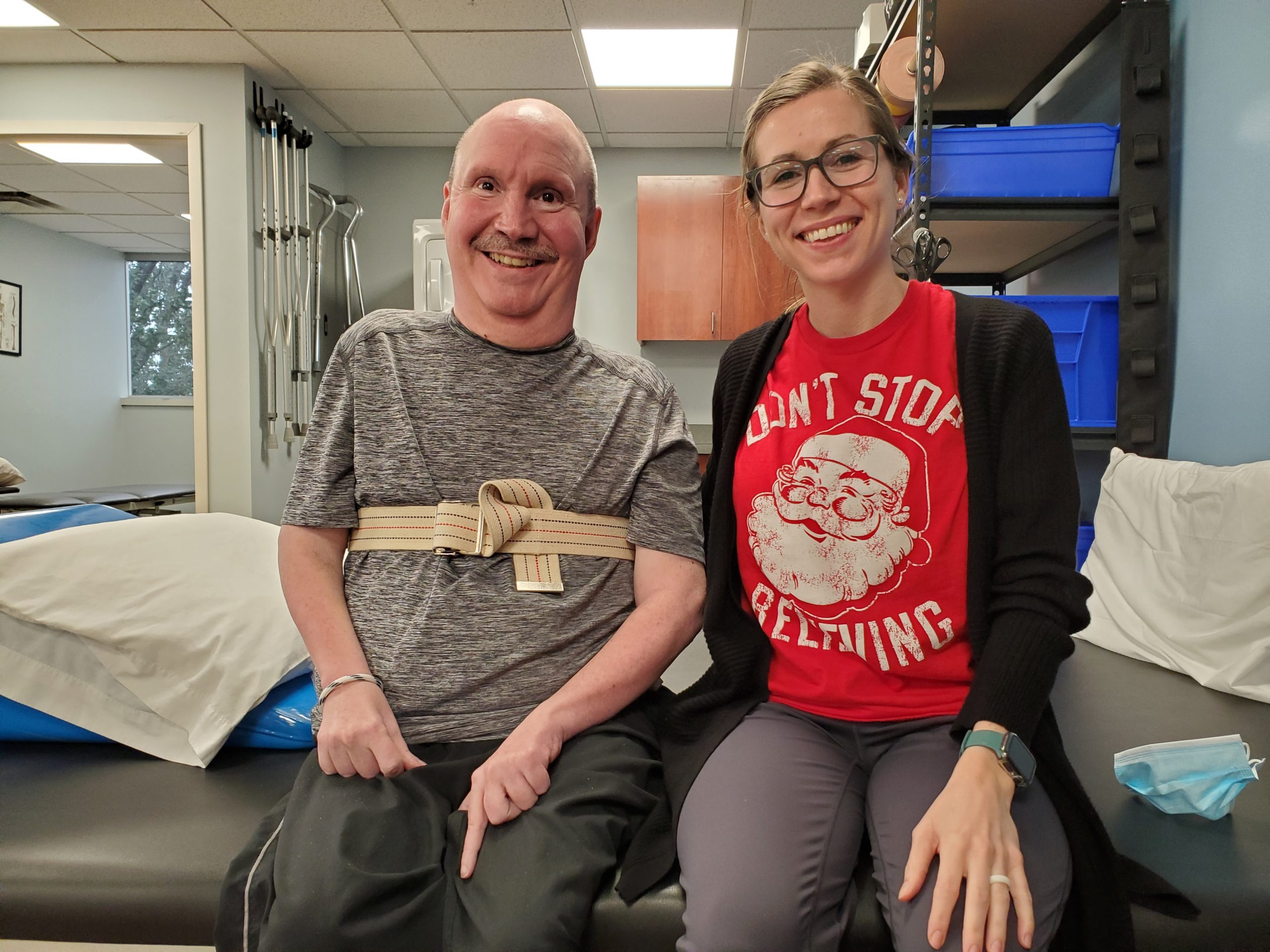Setting physical therapy goals takes collaboration, communication
SMA patients' personal goals can help drive personalized treatment plan

From left, SMA patient Michael Morale smiles with physical therapist Emily Jones. (Photo courtesy of Michael Morale)
When you begin working with a patient with spinal muscular atrophy (SMA), it’s likely you will be working with them for several years. Over time, it is natural to form a bond with them, which will enable you to provide a more in-depth and more personalized treatment plan. It will be important to discuss goals with your patient and make sure they have a say in their treatment plan.
Goals will change throughout the years as some goals will be met and others will need to be modified. Some objectives will be met quickly, such as coming up with a home exercise program and getting the patient familiar with it. Sometimes targets have to change.
For example, when I first started working with Michael, a patient who has SMA, we set goals for being able to independently reach to improve function. After working with him for a while, this goal was modified to be able to independently move his hand on and off of the wheelchair joystick to make the goal more specific and meaningful to Michael.
SMA is a neuromuscular progressive disease and as different treatments come out and as your patient ages, you will change goals. For example, right now with my patient Michael, I have several range of motion or mobility goals set for him. We have been able to significantly improve his flexibility, although it is difficult to maintain due to the limited mobility allowed throughout his daily life. He sits in his wheelchair or in his bed all day, which allows for his knees and hips to be flexed the majority of the time. With his current capabilities and medications, he won’t be able to gain much strength.
Although we have progressed significantly in his endurance and overall core control, it isn’t realistic for me to set a goal for him to be able to perform a full knee range of motion action due to his lack of strength. We hope to set more strength-specific goals if the Food and Drug Administration approves apitegromab, an experimental muscle-directed therapy being developed by Scholar Rock that is designed to improve motor abilities in SMA patients.
Throughout our frequent conversations, we discuss how Michael has progressed and changed over the years. We also talk about what new things have become available and issues that we can address. For example, Michael recently started having more pain in his right leg stemming from his coccyx. With this increase in pain, we shifted our treatments to include some coccyx mobilizations to reduce pain with prolonged sitting as well as adding a goal to include increased sitting time with reduced pain.
Michael also will be able to start utilizing his new wheelchair within the next month. Once he gets into the new chair, there will be new goals to set as well. He will have many different features and will require goals for independent pressure relieving and being able to navigate through obstacles. This will require control throughout his core, so he is able to maintain an upright posture while moving throughout while using his new chair.
As we continue to progress through treatments, we will continue to maintain an open line of communication to ensure the goals we have set and the treatment plan we have is what is best for Michael. I will continue to ensure Michael knows he has the final say in all of his treatments as well as the goals we set. Ultimately, my job is to help him maintain as much independence and comfort throughout his day, whatever that may look like.
Patient perspective
I’ve always felt I had a voice when it came to my physical therapy. When I began working with Emily, I immediately knew she would always have my best interests at heart. Even though we may have a set of routine exercises that we do each week, if I tell her I’m experiencing any discomfort or pain in a certain area of my body, she’s always focused on relieving the tension or discomfort that I may be experiencing.
A couple of weeks ago, while she was working with me on my stretching and range of motion, I told her that I was experiencing quite a bit of discomfort in my right calf. She immediately started massaging my right calf and found a knot in the muscle. After only a few minutes of massaging my calf, the pain was relieved and it’s been much better.
The first question Emily asks me each week is how I’m feeling. While this may be just a simple question, I know that she’s asking me if there’s anything I would like her to work on during my PT session. She and I have an open line of communication, and I’m never embarrassed about telling her what’s happening with my body and what I would like to work on. If you’re an SMA patient going through physical therapy, make sure your physical therapist listens to what you have to say and will adjust your therapy so that it best suits you.
Emily has always listened to me, and I truly believe this is what has helped me more than anything. Having a physical therapist who takes my best interests to heart makes our relationship as a PT and patient much stronger.



